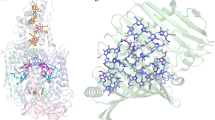Abstract
A quantitative analysis of the excitonic intensity borrowing for the J-/H-aggregates of the bacteriochlorophylls/chlorophylls (BChls/Chls) in specific, and of porphyrins in general, is presented. The analysis is based on the argument that the mixing between the two energetically well-separated bands, such as the Q and B bands of BChls/Chls, should be considered important if the aggregated system possesses an excitonic superstate. A remarkably simple explanation of the significance of the excitonic intensity borrowing is given: superhyperchromism is manifested by the mediation of interband coupling between the superstates in␣the two well-separated bands of such aggregates. A comprehensive discussion on the significance of superhyperchromism and on its size-dependence is provided in connection with its effects on the absorption spectra of the BChl/Chl J- and H-aggregates.
Similar content being viewed by others
Abbreviations
- BChl:
-
bacteriochlorophyll
- Chl:
-
chlorophyll
- LHC:
-
light harvesting complex
References
AS Davydov, Theory of Molecular Excitons. New York: Plenum Press (1971).
C Didraga, JA Klugist and J Knoester, Optical properties of helical cylindrical molecular aggregates: the homogeneous limit. J Phys Chem B 106 (2002) 11474-11486
C Didraga and J Knoester, Excitons in tubular molecular aggregates. J Lum 110 (2004) 239-245
RM Hochstrasser and JD Whiteman, Exciton band structure and properties of a real linear chain in a molecular crystal. J Chem Phys 56 (1972) 5945-5958
R Hoffmann, Excitons by second quantization. Radiat Res 20 (1963) 140-148
RS Knox and BQ Spring, Dipole strengths in the chlorophylls. Photochem Photobiol 77 (2003) 497-501
T Kobayashi, J-aggregates. Singapore: World Scientific (1996).
VI Novoderezhkin, AS Taisova and ZG Fetisova, Unit building block of the oligomeric chlorosomal antenna of green photosynthetic bacterium Chloroflexus aurantiacus: modeling of the nonlinear optical spectra. Chem Phys Lett 335 (2001) 234-240
VI Prokhorenko, DB Steensgaard and AR Holzwarth, Exciton dynamics in the chlorosomal antenna of the green bacteria Chloroflexus aurantiacus and Chlorobium tepidum. Biophys J 79 (2000) 2105-2120
J Psencik, TP Ikonen, P Laurinmaki, MC Merchel, SJ Butcher, RE Serimaa and R Tuma, Lamellar organization of pigments in chlorosomes, the light harvesting complexes of green photosynthetic bacteria. Biophys J 87 (2004) 1165-1172
H Scheer, Chlorophylls. Ann Arbor, MI: CRC Press (1991).
A Scherz and WW Parson, Oligomers of bacteriochlophyll and bacteriophyophytin with spectroscopic properties resembling those found in photosynthetic bacteria. Biochim Biophys Acta 766 (1984a) 653-665
A Scherz and WW Parson, Exciton interactions in dimers of bacteriochlorophyll and related molecules. Biochim Biophys Acta 766 (1984b) 666-678
V Sundström, T Pullerits and R Grondelle van, Photosynthetic light-harvesting: reconciling dynamics and structure of purple bacterial LH2 reveals function of photosynthetic unit. J Phys Chem B 103 (1999) 2327-2346
H Tamiaki, M Amakawa, AR Holzwarth and K Schaffner, Aggregation of synthetic metallochlorins in hexane. A model of chlorosomal bacteriochlorophyll self-assemblies in green bacteria. Photosynth Res 71 (2002) 59-67
Tinoco I (1960) Hypochromism in polynucleotides. J Am Chem Soc 82: 4785–4790; corrected in (1961) J Chem Phys 34: 1067
M Umetsu, ZY Wang, M Kobayashi and T Nozawa, Interaction of photosynthetic pigments with various organic solvents: magnetic circular dichroism approach and application to chlorosomes. Biochim Biophys Acta 1410 (1999) 19-31
H Amerongen Van, L Valkunas and R Grondelle van, Photosynthetic Excitons. Singapore: World Scientific (2000).
H Amerongen Van and R Grondelle van, Understanding the energy transfer function of LHCII, the major light-harvesting complex of green plants. J Phys Chem B 105 (2001) 604-617
M Wendling, MA Przyjalgowski, D Gülen, SIE Vulto, TJ Aartsma, R Grondelle van and H Amerongen van, The quantitative relationship between structure and polarized spectroscopy in the FMO complex of Prosthecochloris aestuarii. Refining experiments and simulations. Photosynth Res 71 (2002) 99-123
H Yı ıldı ırı ım, Eİ İşeri and D Gülen, A quantitative analysis of excitonic superhyperchromism in porphyrin J-/H-aggregates. Chem Phys Lett 391 (2004) 302-307
Author information
Authors and Affiliations
Corresponding author
Rights and permissions
About this article
Cite this article
Gülen, D. Significance of the Excitonic Intensity Borrowing in the J-/H-aggregates of Bacteriochlorophylls/Chlorophylls. Photosynth Res 87, 205–214 (2006). https://doi.org/10.1007/s11120-005-8408-2
Received:
Accepted:
Published:
Issue Date:
DOI: https://doi.org/10.1007/s11120-005-8408-2




